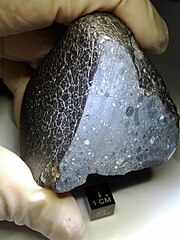NWA 7034
NWA (Northwest Africa) 7034 is a planetary stone meteorite that has a high probability of originating from the planet Mars . It is the second oldest meteorite known from Mars, has the highest water content of all Martian meteorites and is the first meteorite of a new Martian meteorite group called "Martian meteorite (basaltic breccia)".
Find and name
The meteorite was found in the Sahara , a more precise location is not possible. In 2011 the meteorite was sold by a dealer in Morocco to a collector from the USA. He left a piece of the meteorite to the University of New Mexico . As for all meteorites for which the exact location is unknown, the name consists of the geographical region (North West Africa) and a number that is issued consecutively. The nickname, which was also used frequently in the press, is "Black Beauty".
description
NWA 7034 is an achondrite from the meteorite type . It is a volcanic breccia with a porphyroclastic structure. The largest clasts consist of pyroxene ( pigeonite and augite ) and plagioclase ( andesine ) and can reach a diameter of up to 5 mm. In addition, chlorapatite , chromite , ilmenite , magnetite , alkali feldspar and pyrite also occur as accessories . There are also clasts of solidified melt. The basic mass consists of fine-grained plagioclase, pyroxene, various oxides and traces of iron sulfides.
The high water content could indicate that the earlier oceans of Mars still existed when the meteorite's rocks were formed.
The formation of the rock from which the meteorite was formed is dated to 2.089 ± 0.081 billion years, a point in time at the beginning of the Amazonian period of Mars. The meteorite is the second oldest rock sample known from Mars.
classification
If the meteorite were terrestrial rock, it would be classified as a basalt breccia. The fact that the meteorite came from Mars was mainly evident from the appropriate iron / manganese ratio. However, it did not fit into any of the three groups of SNC meteorites ( Shergotite , Nakhlite and Chassignite ) and not to ALH 84001 . It was therefore classified as an ungrouped planetary achondrite until January 2013, when the "Meteoritical Society" accepted the grouping as a "Martian meteorite (basaltic breccia)".
The iron / manganese ratio is an indication of an affinity for the planet Mars. The oxygen isotope ratio speaks against the affinity for Mars. However, this deviation could result from metasomatosis or processes during impact breccation. A meteorite with a different isotope ratio could have contaminated the crust of Mars.
credentials
- ↑ http://www.nasa.gov/mission_pages/mars/news/mars20130103.html
- ↑ a b c NWA 7034 . Meteoritical Society. Retrieved January 4, 2013.
- ↑ Guidelines for meteorite nomenclature . Meteoritical Society. Retrieved January 4, 2013.
- ↑ a b Black beauty with a hot past. In: Spiegel Online. January 4, 2013, accessed December 5, 2014 .
- ↑ a b c C. B. Agee, Wilson, NV; McCubbin, FM; Ziegler, K .; Polyak, VJ; Sharp, ZD; Asmerom, Y .; Nunn, MH; Shaheen, R .; Thiemens, MH; Steele, A .; Fogel, ML; Bowden, R .; Glamoclija, M .; Zhang, Z .; Elardo, SM: Unique Meteorite from Early Amazonian Mars: Water-Rich Basaltic Breccia Northwest Africa 7034 . In: Science . January 3, 2013. doi : 10.1126 / science.1228858 . Retrieved January 4, 2013.
- ↑ 'Black Beauty' rock is a 2 billion year old unique 'meteorite' from Mars, say scientists . Independent. Retrieved January 5, 2013.
- ↑ http://www.nasa.gov/mission_pages/mars/news/mars20130103.html
